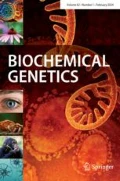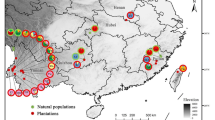Abstract
Ottelia acuminata is an edible aquatic plant species that is endemic to southwestern China. This plant has experienced habitat degradation resulting from environmental change and extensive human disturbance. Determining the genetic variation and genetic structure of O. acuminata populations could help develop strategies to collect, evaluate, utilize and conserve the species. To this end, we genotyped 183 individuals sampled throughout the species distribution using twelve novel nuclear microsatellite loci (nSSRs). Eight of these nSSRs exhibited low average levels of genetic diversity (HE = 0.351, Ho = 0.376) and showed evidence of significant inbreeding across several populations. A high degree of genetic differentiation was identified among populations (FST = 0.457), probably resulting from limited pollen and seed-mediated gene flow. Only 17.8% of variation existed between O. acuminata var. acuminata and other O. acuminata varieties. Bayesian analysis and a UPGMA dendrogram based on Nei’s genetic distance also revealed notably low genetic differentiation among the varieties. This low genetic differentiation is possibly attributed to shared ancestral polymorphisms since their divergence. Additional taxonomic and phylogenetic studies with additional molecular markers are needed to determine the population genetic relationship between O. acuminata varieties. Conservation of this species depends on in situ and ex situ actions, such as controlling habitat water pollution and overexploitation and creating a germplasm bank based on the population genetic differences. To the best of our knowledge, this study represents the first attempt to understand the population genetics of O. acuminata in China using novel nSSR markers developed from transcriptome sequencing and could contribute to the conservation management of this economic plant.






Similar content being viewed by others
References
Abbasi S, Afsharzadeh S, Saeidi H, Triest L (2016) Strong genetic differentiation of submerged plant populations across mountain ranges: evidence from Potamogeton pectinatus in Iran. PLoS ONE 11(8):e0161889
Allan JD (2004) Landscapes and riverscapes: the influence of land use on stream ecosystems. Annul Rev Ecol Evol S 35(1):257–284
Allendorf FW, Likart G (2006) Conservation and the genetics of populations. Blackwell, Malden
Barrett SCH, Eckert CG, Husband BC (1993) Evolutionary processes in aquatic plant populations. Aquat Bot 44(2–3):105–145
Chen JM, Du ZY, Long ZC, Gichira AW, Wang QF (2017) Molecular divergence among varieties of Ottelia acuminata (Hydrocharitaceae) in the Yunnan-Guizhou Plateau. Aquat Bot 140:62–68
Dieringer D, Schlotterer C (2003) MICROSATELLITE ANALYSER (MSA): a platform independent analysis tool for large microsatellite data sets. Mol Ecol Notes 3(1):167–169
Doyle J (1991) DNA protocols for plants—CTAB total DNA isolation. In: Hewitt GM, Johnston A (eds) Molecular techniques in taxonomy. Springer, Berlin
Evanno G, Regnaut S, Goudet J (2005) Detecting the number of clusters of individuals using the software structure: a simulation study. Mol Ecol 14(8):2611–2620
Excoffier L, Smouse PE, Quattro JM (1992) Analysis of molecular variance inferred from metric distances among DNA haplotypes: application to human mitochondrial DNA restriction data. Genetics 131(2):479–491
Excoffier L, Laval G, Schneider S (2005) Arlequin (version 3.0): an integrated software package for population genetics data analysis. Evol Bioinform Online 1:47–50
Ferriol M, Pichot C, Lefevre F (2010) Variation of selfing rate and inbreeding depression among individuals and across generations within an admixed Cedrus population. Heredity 106(1):146–157
Frankham R, Briscoe DA, Ballou JD (2002) Introduction to conservation genetics. Cambridge University Press, Cambridge
Goudet J (2001) FSTAT: a program to estimate and test gene diversities and fixation indices (version 2.9.3)
Hamrick JL, Godt MJW (1990) Allozyme diversity in plant species. In: Brown AHD, Clegg MT, Kahler AL, Weir BS (eds) Plant population genetics, breeding, and genetic resources. Sinauer Associates, Sunderland
Hamrick JL, Godt MJW, Sherman-Broyles SL (1992) Factors influencing levels of genetic diversity in woody plant species. New For 6(1):95–124
He JB, Sun XZ (1991) The infraspecific classification of the populations of Ottelia acuminata (Gagnep.) Dandy. J Wuhan Univ (Nat Sci Ed) 3:114–120
Hedrick PW, Miller PS (1992) Conservation genetics: techniques and fundamentals. Ecol Appl 2(1):30–46
Jakobsson M, Rosenberg NA (2007) CLUMPP: a cluster matching and permutation program for dealing with label switching and multimodality in analysis of population structure. Bioinformatics 23(14):1801–1806
Jestrow B et al (2016) Genetic diversity and differentiation of the Critically Endangered Hispaniolan palm Coccothrinax jimenezii MM Mejia & RG Garcia based on novel SSR markers. Biochem Syst Ecol 66:216–223
Jiang ZT, Li H, Dao ZL (2005) Ottelia acuminata var. songmingensis, a new variety of the Hydrocharitaceae from Yunnan, China. Guihaia 25:424–425
Jiang ZT, Li H, Dao ZL, Long CL (2010) Ethnobotanical study on Ottelia acuminata, an aquatic edible plant occurring in Yunnan. J Inner Mongolia Normal Univ (Nat Sci Ed) 39(2):163–168
Ledig FT, Hodgskiss PD, Jacob-Cervantes V (2002) Genetic diversity, mating system, and conservation of a Mexican subalpine relict, Picea mexicana Martínez. Conserv Genet 3(2):113–122
Li H (1981) Classification, distribution and phylogeny of the genus Ottelia. Acta Phytotaxon Sin 19(1):29–42
Li H (1987) The lake vegetation of Hengduan Mountains. Acta Bot Yunnan 9:257–270
Li NY, Tian K, Chen YH, Liu ZP, Li J, Ao XY, Lei R (2015) Changes of Ottelia acuminata communities in the lakes of northwestern Yunnan Plateau over the past three decades. J Lake Sci 27(3):401–406
Liu KJ, Muse SV (2005) PowerMarker: an integrated analysis environment for genetic marker analysis. Bioinformatics 21(9):2128–2129
Long CL, Jiang ZT, Dao ZL (2011) Genetic diversity of Ottelia acuminata (Hydrocharitaceae) from the Eastern Himalayas, revealed by ISSR markers. Botanica Orientalis J Plant Sci 7:56–63
Lu RR, Yang ZY, Tao CC, Chen ST, Ji YH (2014) Microsatellites primer development for Ottelia acuminata (Hydrocharitaceae),a submerged macrophyte endemic to southwestern China. Guihaia 34(1):34–37, 83
Manni F, Guerard E, Heyer E (2004) Geographic patterns of (genetic, morphologic, linguistic) variation: how barriers can be detected by using Monmonier’s algorithm. Hum Biol 76(2):173–190
Mantel N (1967) The detection of disease clustering and a generalized regression approach. Cancer Res 27(2 Part 1):209–220
Minder AM, Widmer A (2008) A population genomic analysis of species boundaries: neutral processes, adaptive divergence and introgression between two hybridizing plant species. Mol Ecol 17(6):1552–1563
Moreira R, McCauley R, Cortés-Palomec A, Fernandes G, Oyama K (2010) Spatial genetic structure of Coccoloba cereifera (Polygonaceae), a critically endangered microendemic species of Brazilian rupestrian fields. Conserv Genet 11(4):1247–1255
Mutegi E, Snow AA, Rajkumar M, Pasquet R, Ponniah H, Daunay M-C, Davidar P (2015) Genetic diversity and population structure of wild/weedy eggplant (Solanum insanum, Solanaceae) in southern India: implications for conservation. Am J Bot 102(1):140–148
Nei M, Tajima F, Tateno Y (1983) Accuracy of estimated phylogenetic trees from molecular data. J Mol Evol 19(2):153–170
Nybom H (2004) Comparison of different nuclear DNA markers for estimating intraspecific genetic diversity in plants. Mol Ecol 13(5):1143–1155
Peakall R, Smouse PE (2006) Genalex 6: genetic analysis in Excel. Population genetic software for teaching and research. Mol Ecol Notes 6(1):288–295
Peterson BJ et al (2013) Genetic diversity and gene flow in Zostera marina populations surrounding Long Island, New York, USA: no evidence of inbreeding, genetic degradation or population isolation. Aquat Bot 110:61–66
Petit RJ, El Mousadik A, Pons O (1998) Identifying populations for conservation on the basis of genetic markers. Conserv Biol 12(4):844–855
Pritchard JK, Stephens M, Donnelly P (2000) Inference of population structure using multilocus genotype data. Genetics 155(2):945–959
Rosenberg NA (2004) DISTRUCT: a program for the graphical display of population structure. Mol Ecol Notes 4(1):137–138
Schaal BA, Olsen KM (2000) Gene genealogies and population variation in plants. Proc Natl Acad Sci USA 97(13):7024–7029
Schueler S et al (2013) Adaptive genetic diversity of trees for forest conservation in a future climate: a case study on Norway spruce in Austria. Biodivers Conserv 22(5):1151–1166
Slatkin M (1985) Gene flow in natural populations. Annu Rev Ecol Syst 16:393–430
Tamura K, Peterson D, Peterson N, Stecher G, Nei M, Kumar S (2011) MEGA5: molecular evolutionary genetics analysis using maximum likelihood, evolutionary distance, and maximum parsimony methods. Mol Biol Evol 28(10):2731–2739
Van Oosterhout C, Hutchinson WF, Wills DPM, Shipley P (2004) MICRO-CHECKER: software for identifying and correcting genotyping errors in microsatellite data. Mol Ecol Notes 4(3):535–538
Wang QF, Guo YH, Haynes RR, Hellquist CB (2010) Hydrocharitaceae. In: Wu ZY, Peter HR (eds) Flora of China, vol 23. Science Press and Missouri Botanical Garden Press, Beijing and St. Louis, pp 91–102
Williams P, Whitfield M, Biggs J, Bray S, Fox G, Nicolet P, Sear D (2004) Comparative biodiversity of rivers, streams, ditches and ponds in an agricultural landscape in Southern England. Biol Conserv 115(2):329–341
Wilson GA, Rannala B (2003) Bayesian inference of recent migration rates using multilocus genotypes. Genetics 163(3):1177–1191
Wright S (1931) Evolution in mendelian populations. Genetics 16:97–159
Wright S (1943) Isolation by distance. Genetics 28(2):114
Xia J, Lu J, Wang ZX, Hao BB, Wang HB, Liu GH (2013) Pollen limitation and Allee effect related to population size and sex ratio in the endangered Ottelia acuminata (Hydrocharitaceae): implications for conservation and reintroduction. Plant Biol 15(2):376–383
Xu C, Du ZY, Chen JM, Wang QF (2012) Microsatellite primers for the endangered aquatic herb, Ottelia acuminata (Hydrocharitaceae). Am J Bot 99(6):E262–E264
Yang M, Liu F, Han YN, Xu LM, Juntawong M, Liu YL (2013) Genetic diversity and structure in populations of Nelumbo from America, Thailand and China: implications for conservation and breeding. Aquat Bot 107:1–7
Yao XH, Ye QG, Kang M, Huang HW (2007) Microsatellite analysis reveals interpopulation differentiation and gene flow in the endangered tree Changiostyrax dolichocarpa (Styracaceae) with fragmented distribution in central China. New Phytol 176(2):472–480
Young A, Boyle T, Brown T (1996) The population genetic consequences of habitat fragmentation for plants. Trends Ecol Evol 11(10):413–418
Yuan N, Sun Y, Comes HP, Fu CX, Qiu YX (2014) Understanding population structure and historical demography in a conservation context: population genetics of the endangered Kirengeshoma palmata (Hydrangeaceae). Am J Bot 101(3):521–529
Zhai SH, Wang B, Wang DK, Zhang GF (2010) Caryotype of Ottelia acuminata var. lunanensis H. Li and evolution of Ottelia Pers. J Lake Sci 22(5):735–738
Zhang HY, Tian K, Yu Y, Li LY, Yang YM (2009) Genetic diversity among natural populations of Ottelia acuminata (Gaghep.) Dandy revealed by ISSR. Afr J Biotechnol 8(22):6089–6093
Acknowledgements
This work was supported by the National Natural Science Foundation of China (No. 31360065) and the Applied Basic Research Project of Yunnan Province (No. 2016FD107).
Author information
Authors and Affiliations
Corresponding author
Electronic supplementary material
Below is the link to the electronic supplementary material.
Rights and permissions
About this article
Cite this article
Zhai, S.H., Yin, G.S. & Yang, X.H. Population Genetics of the Endangered and Wild Edible Plant Ottelia acuminata in Southwestern China Using Novel SSR Markers. Biochem Genet 56, 235–254 (2018). https://doi.org/10.1007/s10528-018-9840-2
Received:
Accepted:
Published:
Issue Date:
DOI: https://doi.org/10.1007/s10528-018-9840-2




